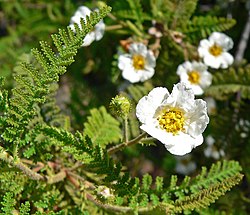| Chamaebatia | |
|---|---|
 | |
| Chamaebatia australis | |
| Scientific classification | |
| Kingdom: | Plantae |
| Clade: | Tracheophytes |
| Clade: | Angiosperms |
| Clade: | Eudicots |
| Clade: | Rosids |
| Order: | Rosales |
| Family: | Rosaceae |
| Subfamily: | Dryadoideae |
| Genus: | Chamaebatia Benth. |
| Species | |
2; see text. | |
Chamaebatia, also known as mountain misery, is a genus of two species of aromatic evergreen shrubs endemic to California. Its English common name derives from early settlers' experience with the plant's dense tangle and sticky, strong-smelling resin. [1] [2] They are actinorhizal, non-legumes capable of nitrogen fixation through symbiosis with the actinobacterium, Frankia . [3] [4]